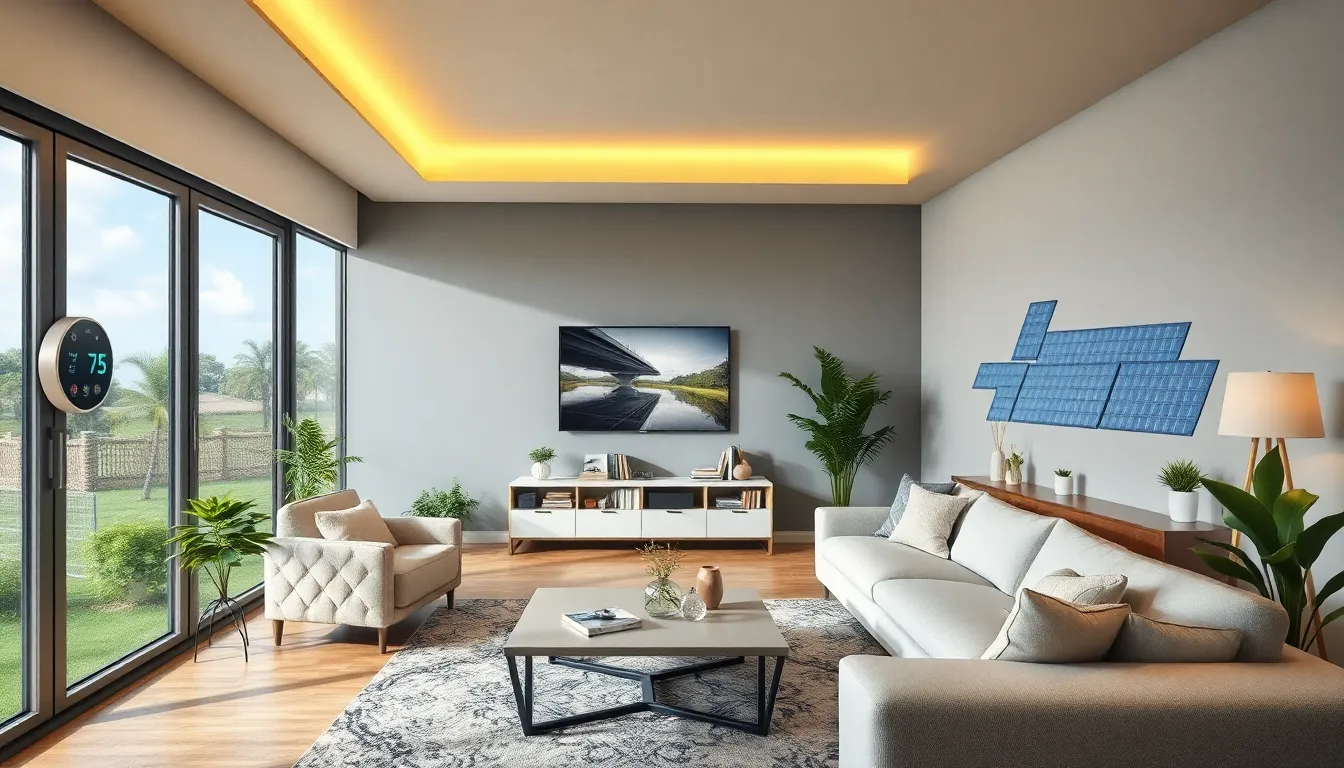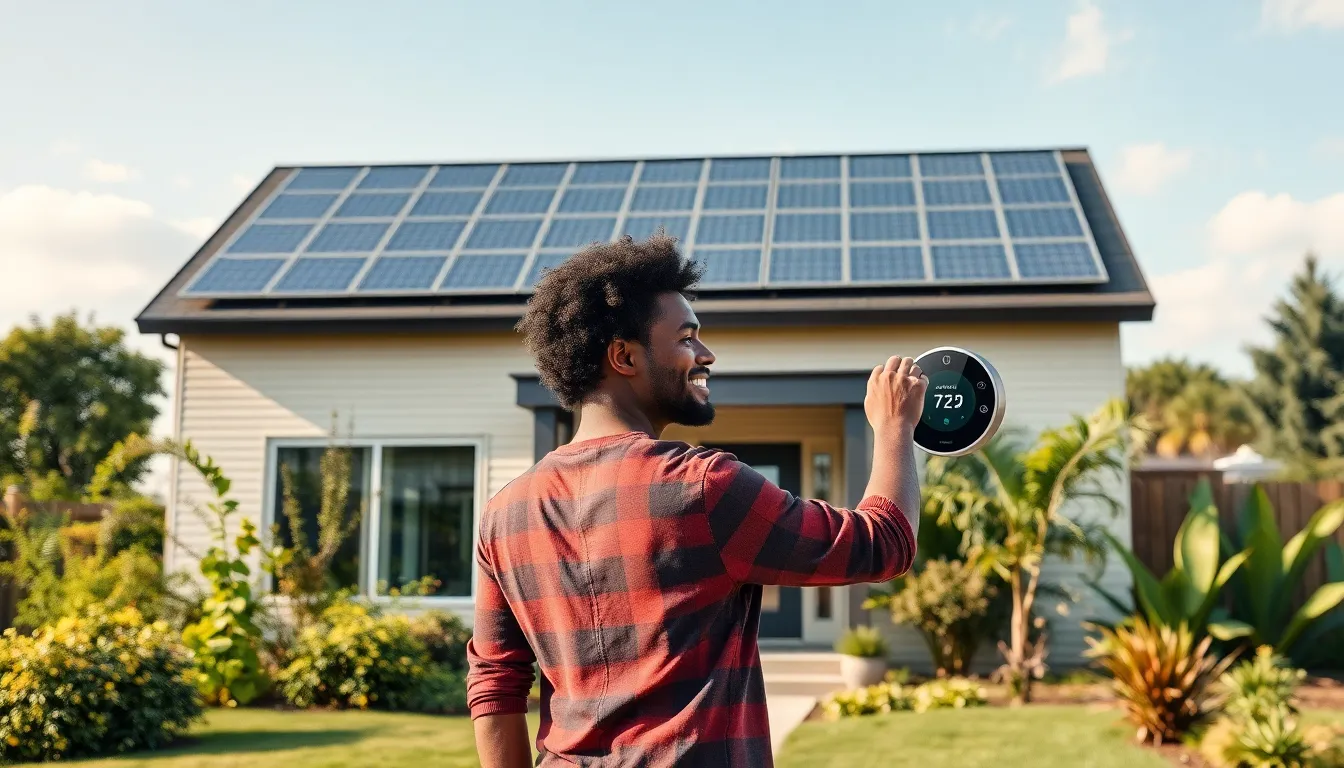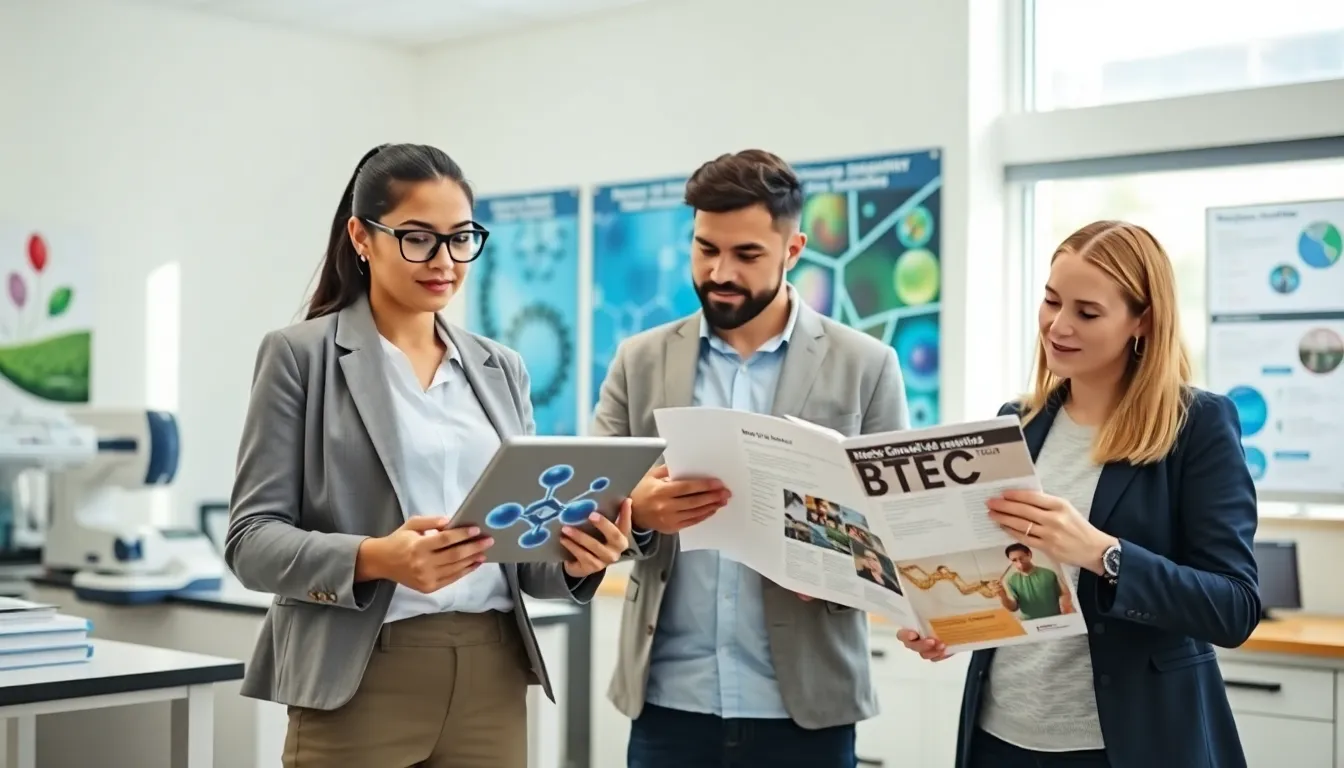In today’s world, the push for sustainability has never been more crucial. As homeowners seek to reduce their carbon footprint, green smart home solutions are emerging as a game-changer. These innovative technologies not only enhance comfort and convenience but also promote energy efficiency and environmental responsibility.
From smart thermostats that optimize heating and cooling to solar panels that harness renewable energy, the options are diverse and impactful. Embracing these solutions means transforming living spaces into eco-friendly havens while saving money on utility bills. As the demand for greener lifestyles grows, understanding the benefits and possibilities of green smart home solutions becomes essential for every homeowner.
Table of Contents
ToggleOverview of Green Smart Home Solutions
Green smart home solutions focus on integrating technology with sustainability to create energy-efficient living environments. These solutions encompass a variety of products and systems designed to optimize energy consumption and minimize environmental impact.
Smart thermostats help regulate heating and cooling systems, allowing users to maintain comfortable temperatures while using less energy. These devices learn user preferences and adjust settings, which can lead to energy savings of up to 10-15% annually.
Solar panels harness sunlight to generate electricity, significantly reducing reliance on non-renewable energy sources. Homeowners can lower utility bills significantly, with some systems offering savings of thousands of dollars over their lifespan.
Energy-efficient appliances, such as smart refrigerators and washing machines, consume less water and energy compared to traditional models. These appliances integrate smart technology, providing remote monitoring and control, which further enhances energy conservation.
Home automation systems streamline the management of various devices and appliances. By connecting smart devices, users can create energy-efficient settings, such as scheduling lights to turn off when no one is home.
Rainwater harvesting systems collect and store rainwater for irrigation and other non-potable uses, reducing the demand on municipal water systems. These systems can significantly contribute to water conservation efforts.
Sustainable landscaping practices, including the use of native plants and xeriscaping, complement green smart home solutions. These practices require less water and maintenance, leading to significant resource savings.
Green smart home solutions not only promote environmental responsibility but also offer financial benefits. Homeowners experience reduced energy costs, increased property values, and potential tax incentives associated with energy-saving improvements.
Benefits of Green Smart Home Solutions

Green smart home solutions offer numerous advantages that enhance sustainability while improving daily living. These technologies not only promote energy efficiency but also provide significant financial benefits for homeowners.
Energy Efficiency
Energy efficiency stands as a primary advantage of green smart home solutions. Smart thermostats adjust heating and cooling based on occupancy and preferences, leading to energy savings of 10-15% annually. Energy-efficient appliances, like LED lights and smart refrigerators, consume less electricity and water than traditional models. Home automation systems enable homeowners to control energy usage remotely, allowing them to turn off devices when not in use. These solutions reduce overall energy consumption, lower greenhouse gas emissions, and foster a more sustainable lifestyle.
Cost Savings
Cost savings emerge as another critical benefit of green smart home solutions. Solar panels significantly decrease reliance on non-renewable energy sources, offering long-term savings on utility bills. Energy-efficient appliances reduce operating costs through lower energy and water usage. Furthermore, smart home technologies can qualify homeowners for tax incentives, rebates, or credits, making upgrades more financially feasible. Over time, these savings contribute to a noticeable reduction in household expenditures while enhancing property values as sustainability becomes increasingly desirable.
Popular Green Smart Home Technologies
Green smart home technologies enhance energy efficiency and promote sustainability. Below are key technologies that contribute to eco-friendly living environments.
Smart Thermostats
Smart thermostats provide optimal control over heating and cooling systems. They analyze usage patterns, adjusting temperatures accordingly, which leads to energy savings of 10-15% annually. Homeowners can access these devices remotely through smartphones, allowing for adjustments based on occupancy. Popular models include the Nest Learning Thermostat and Ecobee SmartThermostat, both known for their user-friendly interfaces and energy-saving capabilities.
Solar Panels
Solar panels harness renewable energy from the sun, significantly reducing dependence on non-renewable sources. These systems convert sunlight into electricity, which can power homes or be stored for later use. Homeowners often experience a reduction in utility bills up to 50% after installation. Additionally, federal and state incentives encourage adoption, making solar solutions increasingly feasible. Companies like SunPower and LG provide high-efficiency solar panel systems designed for various home setups.
Energy Monitoring Systems
Energy monitoring systems track and analyze energy consumption in real-time. They provide insights into usage patterns, helping homeowners identify energy waste and optimize appliance use. Some systems integrate with smart home devices, offering automated energy-saving features. Popular options, such as Sense and TP-Link Kasa, empower homeowners to make data-driven decisions that enhance energy efficiency and reduce living costs.
Challenges in Implementing Green Smart Home Solutions
Implementing green smart home solutions presents several challenges that homeowners must navigate. These challenges often revolve around financial constraints and technology integration.
Initial Investment
Initial investment costs pose a significant barrier for many homeowners. Smart home technologies, like solar panels and energy-efficient appliances, often require substantial upfront expenditures. For example, solar panel installation can range between $15,000 and $25,000 depending on system size and location. While continued savings on utility bills and possible tax incentives can offset these costs over time, the immediate financial outlay can discourage adoption. Homeowners must evaluate financing options, like loans or leasing agreements, which may alleviate some financial pressure but can still complicate the decision-making process.
Technology Adoption
Technology adoption also presents challenges in transitioning to green smart home solutions. Homeowners might face difficulties understanding how to integrate various technologies within their existing setups. Compatibility issues often arise when attempting to connect new devices with older home systems. Moreover, the learning curve associated with using advanced technologies like smart thermostats or home automation systems can hinder user engagement. Without proper training or access to support, homeowners might not maximize the benefits these systems offer, ultimately leading to dissatisfaction or abandonment of the technologies.
Future Trends in Green Smart Home Solutions
Emerging trends in green smart home solutions focus on integration, convenience, and sustainability. Homeowners increasingly prioritize technologies that enhance energy efficiency while offering seamless user experiences.
Advanced Energy Management Systems
Advanced energy management systems optimize energy usage through machine learning. These systems analyze consumption patterns and adjust settings automatically. An example includes systems that integrate with solar panels, which allow homeowners to store excess energy for future use.
Smart Home Integration
Smart home integration enhances convenience by connecting various devices through unified platforms. Future technologies enable compatibility among devices, regardless of the brand. For instance, platforms like Apple HomeKit and Amazon Alexa facilitate interactions between smart thermostats, lighting, and security systems.
Enhanced Sustainability Features
Enhanced sustainability features are becoming essential in new home construction and renovation projects. Developers are increasingly incorporating sustainable materials and energy-efficient designs. Innovations such as green roofs and passive solar designs contribute to overall energy efficiency.
Eco-Friendly Appliances
Eco-friendly appliances are evolving with smart features that promote sustainability. These appliances go beyond energy efficiency; they use advanced sensors to reduce waste. For instance, smart dishwashers adjust water usage based on load size, minimizing consumption.
Smart Water Management
Smart water management systems focus on conserving water resources. Technologies include smart irrigation systems that monitor soil moisture and weather conditions to optimize watering schedules. Homeowners benefit from reduced water usage and utility costs, achieving sustainable landscaping practices.
Renewable Energy Innovations
Renewable energy innovations drive future green homes toward energy self-sufficiency. Breakthroughs in solar panel technology, such as bifacial panels, capture sunlight from both sides, increasing overall efficiency. This innovation may enhance system accessibility and affordability over time.
Legislative Support
Legislative support for green initiatives will shape the future landscape of smart home solutions. Governments increasingly implement incentives for adopting sustainable technologies, aiding homeowners in making eco-friendly upgrades. Policies encouraging energy-saving practices contribute to a broader acceptance of green smart home solutions.
Embracing green smart home solutions is a crucial step towards a sustainable future. These technologies not only enhance energy efficiency but also provide significant cost savings for homeowners. By integrating smart devices and renewable energy sources, individuals can create comfortable living spaces while minimizing their environmental impact.
As the demand for sustainable living continues to rise, understanding the benefits and options available becomes essential. Homeowners have the opportunity to invest in technologies that promote eco-friendliness and contribute to long-term savings. With advancements in smart home integration and renewable energy, the path to a greener lifestyle is more accessible than ever.



